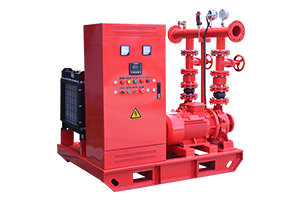-
 Jul 29, 2024What are the considerations for fire pump systems in agricultural facilities?- Protection of Crops and Livestock: Ensuring systems provide reliable fire protection for crops, livestock, and agricultural infrastructure.
Jul 29, 2024What are the considerations for fire pump systems in agricultural facilities?- Protection of Crops and Livestock: Ensuring systems provide reliable fire protection for crops, livestock, and agricultural infrastructure.
- Rural Water Supply Management: Implementing solutions that manage water supply efficiently in rural areas.
- Durability and Weather Resistance: Using materials and designs that withstand harsh environmental conditions.
- Compliance with Agricultural Safety Standards: Adhering to fire safety regulations specific to agricultural operations.View details -
 Jul 26, 2024How do you ensure electric fire pumps are compliant with environmental regulations?Ensuring compliance involves:
Jul 26, 2024How do you ensure electric fire pumps are compliant with environmental regulations?Ensuring compliance involves:
Understanding regulations: Staying informed about local, national, and international environmental regulations.
Eco-friendly materials: Using environmentally friendly materials and components.
Energy efficiency: Selecting high-efficiency motors and controls to minimize energy consumption.
Emissions control: Ensuring that the pump produces no harmful emissions.
Documentation: Keeping detailed records of compliance efforts and certifications.View details -
 Jul 26, 2024What are the considerations for selecting electric fire pumps for high-temperature environments?Heat-resistant materials: Using materials that can withstand high temperatures without degrading.
Jul 26, 2024What are the considerations for selecting electric fire pumps for high-temperature environments?Heat-resistant materials: Using materials that can withstand high temperatures without degrading.
Cooling systems: Implementing effective cooling systems to manage motor and pump temperatures.
Ventilation: Ensuring proper ventilation in the pump room to dissipate heat.
Insulation: Using thermal insulation to protect sensitive components from heat.
Regular monitoring: Continuously monitoring temperatures to prevent overheating and potential failures.View details -
 Jul 25, 2024How do fire pumps integrate with health and safety management systems?- Centralized Monitoring: Providing centralized monitoring and control through health and safety management systems.
Jul 25, 2024How do fire pumps integrate with health and safety management systems?- Centralized Monitoring: Providing centralized monitoring and control through health and safety management systems.
- Real-Time Alerts and Responses: Enabling real-time alerts and automated responses to fire incidents.
- Data Collection and Analysis: Using data collection for compliance reporting and performance optimization.
- Compliance with Occupational Health and Safety Standards: Adhering to fire safety regulations and standards for workplace health and safety.View details -
 Jul 25, 2024What are the considerations for fire pump systems in power generation facilities?- Protection of Critical Infrastructure: Ensuring reliable fire protection for critical power generation equipment.
Jul 25, 2024What are the considerations for fire pump systems in power generation facilities?- Protection of Critical Infrastructure: Ensuring reliable fire protection for critical power generation equipment.
- High Capacity Systems: Implementing systems that can handle the large-scale requirements of power plants.
- Integration with Plant Operations: Coordinating with plant operations to avoid disruption.
- Compliance with Energy Sector Regulations: Adhering to fire safety regulations specific to power generation facilities.
View details -
 Jul 24, 2024How do fire pumps support fire protection in large residential estates and gated communities?- Comprehensive Coverage: Providing comprehensive fire protection for large residential areas and common facilities.
Jul 24, 2024How do fire pumps support fire protection in large residential estates and gated communities?- Comprehensive Coverage: Providing comprehensive fire protection for large residential areas and common facilities.
- High Capacity Systems: Ensuring systems can deliver adequate water supply for extensive residential estates.
- Integration with Security Systems: Coordinating with security systems to enhance overall safety.
- Compliance with Residential Fire Safety Codes: Adhering to fire safety regulations and codes specific to large residential estates.View details






